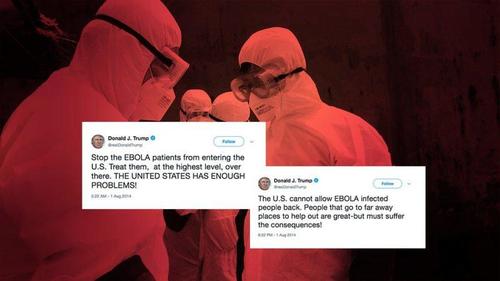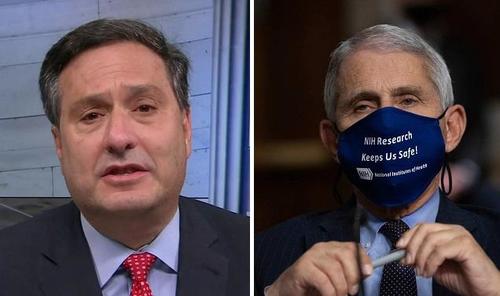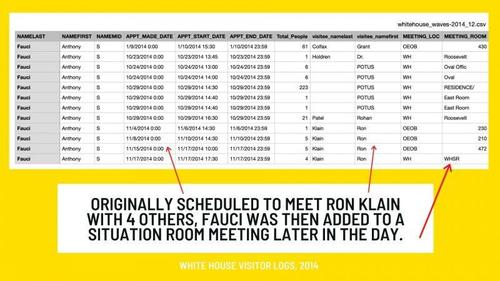Source: Zero Hedge
Authored by Mike McCormick via The National Pulse
A National Pulse review of White House Visitors Logs from November 2014 reveals a meeting in the White House Situation Room, chaired by then-Ebola Czar Ron Klain. The meeting appears to have been coordinated by Dr. Anthony Fauci, and included several high-level U.S. government agency heads.
The high profile summit came just weeks after the Obama administration issued a moratorium on the same “gain of function” experiments that Dr. Fauci now claims were never directly funded by his government agency to take place at the Wuhan lab in China.
Fauci’s insistence, however, is betrayed by new analysis of the sequence of events and examples of his own staff headlining gain of function events in Wuhan.
President Obama and other senior White House officials – potentially including then-Vice President Joe Biden – may also have been present.
The Situation Room Summit, 2014.
On the morning of November 17th, 2014, Dr. Anthony Fauci made his way to the Eisenhower Executive Office Building (EEOB), otherwise known as the Old Executive Office Building (OEOB). The meeting was confirmed in the White House logs by Department for Homeland Security administrator Drew Cramer.
At 10am, he met with the man who would become known 7 years later as Joe Biden’s “prime minister,” Ron Klain. Four others joined Dr. Fauci, including former Walmart executive-turned-Health and Human Services staffer Leslie Dach.
David J Horowitz, who headed the legal side of the Ebola crisis; the Center for Disease Control’s Mitchell Wolfe; and the founding director of the Biomedical Advanced Research and Development Authority (BARDA), Robin Robinson, were all present.
BARDA is described as being “responsible for the procurement and development of medical countermeasures, principally against bioterrorism, including chemical, biological, radiological and nuclear (CBRN) threats, as well as pandemic influenza and emerging diseases.”
Included on the roster for the Situation Room were then Centers for Disease Control Director Thomas Frieden and Rear Admiral Stephen Redd of the U.S. Public Health Service. In other words: a top team discussion.
Visiting government officials are, as a matter of routine, noted in the official records. White House employees, including the President and Vice President, are never logged in this manner.
But the summit was clearly an important one, and appears to have prompted a subsequent discussion later that day in the White House Situation Room, suggesting the involvement of President Obama, or at least then-Vice President Joe Biden.
A new appointment was made on November 17th for later that day, as the above graphic reveals.
Infectious Diseases.
Less than a week before the Situation Room summit, President Obama had declared a new vision for the United States and China in the arena of infectious diseases.
A now archived “Fact Sheet” reads:
The United States expresses appreciation for China’s approximately $130 million in contributions to the international Ebola response. The United States and China are working together to provide needed equipment, supplies, and treatment facilities in Liberia, and our health personnel are working side-by-side to address the Ebola epidemic at its source. The two sides call on all members of the international community to step up their efforts in support of the UN Mission for Ebola Emergency Response. Together, the United States and China are committed to working jointly with partners through the Global Health Security Agenda to develop long-term capacity to prevent, detect, and respond to infectious diseases.
Just ahead of the Obama-Xi agreement, Fauci ushered two additional groups into Rooms 230 and 210 of the Eisenhower Executive Office Building (OEOB) to meet Klain. The dates of these meetings were November 6th and 10th, 2014.
These details may go some way to helping uncover the truth behind the National Institute for Health (NIH) and its alleged funding of gain-of-function experiments at the Wuhan Institute of Virology. The information puts Klain and Obama at the head of the table for the decision to green-light what Fauci has been ferociously denying as of late.
Tony and Ron.
Dr. Fauci and Ron Klain would go on to enjoy a close, working relationship, and these meetings underscore their collaboration on the future of U.S.-CCP collaborative research. Critics may also suggested Dr. Fauci had a political conflict of interest when advising President Trump in the early days of the COVID-19 pandemic. His own party affiliation and his family’s donation history seem to confirm this.
One challenge they faced was to craft a more robust public relations campaign to counter growing media criticism of Obama’s lame Ebola response, the worst of it coming as a result of Donald Trump’s tweets.

As a political operative, Klain was an unusual pick as Ebola Czar. But he was effective.
A Joe Biden loyalist, he did one thing fabulously well, he made Dr. Fauci a media darling and began reversing the Obama administrations public relations misfortunes on their handling of the matter.
Two days after Klain’s appointment to the role on October 17, 2014, Fauci appeared on every television network’s Sunday show to tamp down criticism of the Klain as an Ebola czar. And it worked well for both men.
For Fauci, multiple meetings with Obama would soon follow, including a high-profile hug-fest in the Oval Office on October 24, 2014, in which Fauci introduced Ebola survivor Nina Pham to Obama. The media was enthralled with the “Tony Fauci Healthcare Hero” narrative.
A few years later, Pham sued her employer – Texas Health Resources – and slammed a video featuring her and her doctors as “a public relations stunt and an invasion of privacy.”
Denial over Wuhan.
Fauci and Klain were on the same page in their early assessments of the outbreak in Wuhan.
In a January 21, 2020 interview with Greg Kelly on Newsmax, Fauci said: “This is not a major threat to the people of the United States and this is not something that the citizens of the United States should be worried about right now.”
This was followed by several more weeks of obfuscations and contradictions.
Coming in behind Fauci’s bewildering and unhelpful advice was Ron Klain’s own public statements, such as those made on January 30th 2020, in article in The Atlantic.
The piece by Klain opened with Chinese Communist Party talking points, and went on to parrot Fauci’s downplaying of the virus while more hawkish types such as Steve Bannon and Dr. Peter Navarro banged the drum for immediate action.
“We do not know yet how grave a threat the new coronavirus will turn out to be. On the one hand, scientists have quickly sequenced the virus and are working on a vaccine. China has imposed draconian quarantines to slow the virus’s spread, and is rapidly building massive new hospitals to treat its victims. To date, the U.S. has seen only a handful of cases, all of them the product of travel to China, not transmission here. These are causes for concern, but not overwrought fear,” Klain wrote.
He added:
“Ultimately, the question may never be called on the coronavirus, which could be less of a threat than early indications suggest…”
His conclusion needs no explainer:
“Five presidents—liberals and conservatives, Democrats and Republicans—have looked to Tony Fauci for advice; it is not impossible to imagine Trump being the first to angrily dismiss the counsel he offers if it does not fit with his own poor instincts.”
Trump, in fact, heeded Fauci – to his and the world’s detriment.
Now the world needs to know what was discussed in these critical 2014 meetings, and how Fauci and Klain’s relationship progressed through to the early days of the COVID-19 pandemic.
Raheem Kassam contributed to this article.



